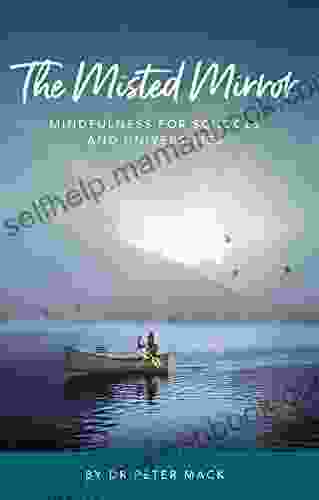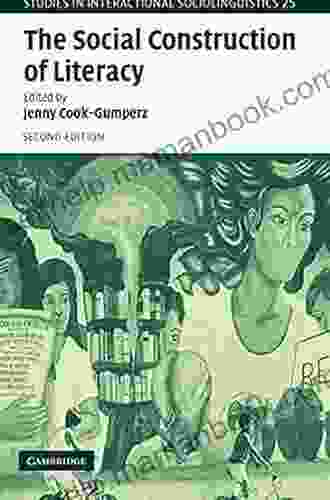The Social Construction of Literacy Studies in Interactional Sociolinguistics

4 out of 5
| Language | : | English |
| File size | : | 5734 KB |
| Screen Reader | : | Supported |
| Print length | : | 332 pages |
Literacy studies have undergone a significant transformation in recent decades, shifting from a focus on individualistic, cognitive processes to an emphasis on the social and cultural construction of literacy practices. This change has been largely influenced by the emergence of interactional sociolinguistics, which examines how language is used in social interaction.
This article provides a comprehensive overview of the social construction of literacy studies in interactional sociolinguistics. It examines the historical roots of this approach, its theoretical underpinnings, and the current debates and controversies that shape the field.
Historical Roots
The social construction of literacy studies in interactional sociolinguistics can be traced back to the work of early scholars such as Dell Hymes and John Gumperz. Hymes's groundbreaking work on the ethnography of speaking (1972) emphasized the importance of understanding the social and cultural context in which language is used. Gumperz's research on conversational inference (1982) showed how the meaning of utterances is shaped by the shared knowledge and assumptions of participants in an interaction.
These early studies laid the foundation for a new approach to literacy studies that focused on the way literacy practices are embedded in social interactions. This approach was further developed by scholars such as Shirley Brice Heath and Brian Street, who conducted ethnographic studies of literacy practices in diverse communities.
Theoretical Underpinnings
The social construction of literacy studies in interactional sociolinguistics is based on a number of theoretical perspectives, including:
- Sociocultural theory: This theory emphasizes the role of social and cultural factors in shaping human development. According to sociocultural theory, literacy is a socially and culturally constructed practice that is acquired through participation in literacy events and activities.
- Situated cognition: This theory posits that cognition is situated in the social and cultural context in which it occurs. In other words, the way we think and learn is shaped by the people and environments around us. Literacy practices, therefore, are not simply a matter of individual skills, but are also embedded in the social and cultural contexts in which they are used.
- Ethnography of communication: This approach to research involves observing and recording naturally occurring social interactions. Ethnographic studies of literacy practices have provided valuable insights into the ways that literacy is used in different communities and contexts.
Current Debates and Controversies
The social construction of literacy studies in interactional sociolinguistics is a dynamic and evolving field of research. There are a number of current debates and controversies that are shaping the field, including:
- The role of technology in literacy practices: The increasing use of digital technologies has raised questions about how literacy is defined and practiced in the 21st century. Some scholars argue that digital technologies are leading to new forms of literacy that are not adequately captured by traditional definitions of literacy.
- The relationship between literacy and power: Literacy has long been associated with power and privilege. Some scholars argue that literacy can be used as a tool to maintain social inequalities, while others argue that literacy can be a tool for empowerment and social change.
- The future of literacy studies: The social construction of literacy studies is a relatively new field of research, and there is still much that we do not know about the social and cultural construction of literacy practices. Some scholars argue that the field should focus on more traditional forms of literacy, while others argue that the field should embrace new forms of literacy that are emerging in the digital age.
The social construction of literacy studies in interactional sociolinguistics is a vibrant and growing field of research. This approach to literacy studies provides a valuable lens for understanding the ways that literacy practices are shaped by social and cultural factors. The field is still in its early stages of development, and there are a number of important debates and controversies that are shaping its future. However, the social construction of literacy studies is an essential field of research for understanding the complex and ever-changing nature of literacy in the 21st century.
References
- Gee, J. P. (2004). Situated language and learning: A critique of traditional schooling. Routledge.
- Heath, S. B. (1983). Ways with words: Language, life, and work in communities and classrooms. Cambridge University Press.
- Hymes, D. (1972). Models of the interaction of language and social life. In J. Gumperz & D. Hymes (Eds.),Directions in sociolinguistics: The ethnography of communication (pp. 35-71). Holt, Rinehart and Winston.
- Street, B. V. (1984). Literacy in theory and practice. Cambridge University Press.
4 out of 5
| Language | : | English |
| File size | : | 5734 KB |
| Screen Reader | : | Supported |
| Print length | : | 332 pages |
Do you want to contribute by writing guest posts on this blog?
Please contact us and send us a resume of previous articles that you have written.
 Top Book
Top Book Novel
Novel Fiction
Fiction Nonfiction
Nonfiction Literature
Literature Paperback
Paperback Hardcover
Hardcover E-book
E-book Audiobook
Audiobook Bestseller
Bestseller Classic
Classic Mystery
Mystery Thriller
Thriller Romance
Romance Fantasy
Fantasy Science Fiction
Science Fiction Biography
Biography Memoir
Memoir Autobiography
Autobiography Poetry
Poetry Drama
Drama Historical Fiction
Historical Fiction Self-help
Self-help Young Adult
Young Adult Childrens Books
Childrens Books Graphic Novel
Graphic Novel Anthology
Anthology Series
Series Encyclopedia
Encyclopedia Reference
Reference Guidebook
Guidebook Textbook
Textbook Workbook
Workbook Journal
Journal Diary
Diary Manuscript
Manuscript Folio
Folio Pulp Fiction
Pulp Fiction Short Stories
Short Stories Fairy Tales
Fairy Tales Fables
Fables Mythology
Mythology Philosophy
Philosophy Religion
Religion Spirituality
Spirituality Essays
Essays Critique
Critique Commentary
Commentary Glossary
Glossary Bibliography
Bibliography Index
Index Table of Contents
Table of Contents Preface
Preface Introduction
Introduction Foreword
Foreword Afterword
Afterword Appendices
Appendices Annotations
Annotations Footnotes
Footnotes Epilogue
Epilogue Prologue
Prologue Melanie Notkin
Melanie Notkin Susan Hall
Susan Hall Dana Hayward
Dana Hayward Lon Safko
Lon Safko Catherine Jones
Catherine Jones Samantha Britt
Samantha Britt Ava Lennart
Ava Lennart Simon Anholt
Simon Anholt Amanda Vickery
Amanda Vickery Y S Hassan
Y S Hassan Kamel Sadi
Kamel Sadi Scott Hutchins
Scott Hutchins Helen Ducal
Helen Ducal Jules Mitchell
Jules Mitchell P A De Voe
P A De Voe C K Fyfe
C K Fyfe Robyn Crane
Robyn Crane Sarah Andersen
Sarah Andersen Patrick Smith
Patrick Smith Ed Gaulden
Ed Gaulden
Light bulbAdvertise smarter! Our strategic ad space ensures maximum exposure. Reserve your spot today!

 Joel MitchellThe Fusion Marketing Bible: A Comprehensive Guide to Modern Marketing Success
Joel MitchellThe Fusion Marketing Bible: A Comprehensive Guide to Modern Marketing Success
 Steven HayesWorld Currency Exchange Program David Blum: Changing the Landscape of Global...
Steven HayesWorld Currency Exchange Program David Blum: Changing the Landscape of Global... Matt ReedFollow ·9.6k
Matt ReedFollow ·9.6k Theo CoxFollow ·10.4k
Theo CoxFollow ·10.4k Patrick HayesFollow ·19.4k
Patrick HayesFollow ·19.4k Jesus MitchellFollow ·6.1k
Jesus MitchellFollow ·6.1k Joel MitchellFollow ·4.8k
Joel MitchellFollow ·4.8k Dean ButlerFollow ·2.8k
Dean ButlerFollow ·2.8k Al FosterFollow ·7.7k
Al FosterFollow ·7.7k Rubén DaríoFollow ·15.8k
Rubén DaríoFollow ·15.8k

 Boris Pasternak
Boris PasternakThe Misted Mirror: Mindfulness for Schools and...
What is The Misted...

 Holden Bell
Holden BellEmbark on Thrilling Adventures in the Uncharted Depths of...
Unveiling the Enchanting...

 Seth Hayes
Seth HayesDelphi Complete Works of Lucan: Illustrated Delphi...
This meticulously edited...

 Jackson Hayes
Jackson HayesThe Enigmatic Cat Burglar: Unraveling the Intriguing...
In the annals of crime, the name Bernie...

 Quentin Powell
Quentin PowellAligned With The Cisa Review Manual 2024 To Help You...
The CISA Review Manual 2024 is the most...

 Austin Ford
Austin FordUnlocking Revenue Potential: A Comprehensive Business...
In today's digital...
4 out of 5
| Language | : | English |
| File size | : | 5734 KB |
| Screen Reader | : | Supported |
| Print length | : | 332 pages |








